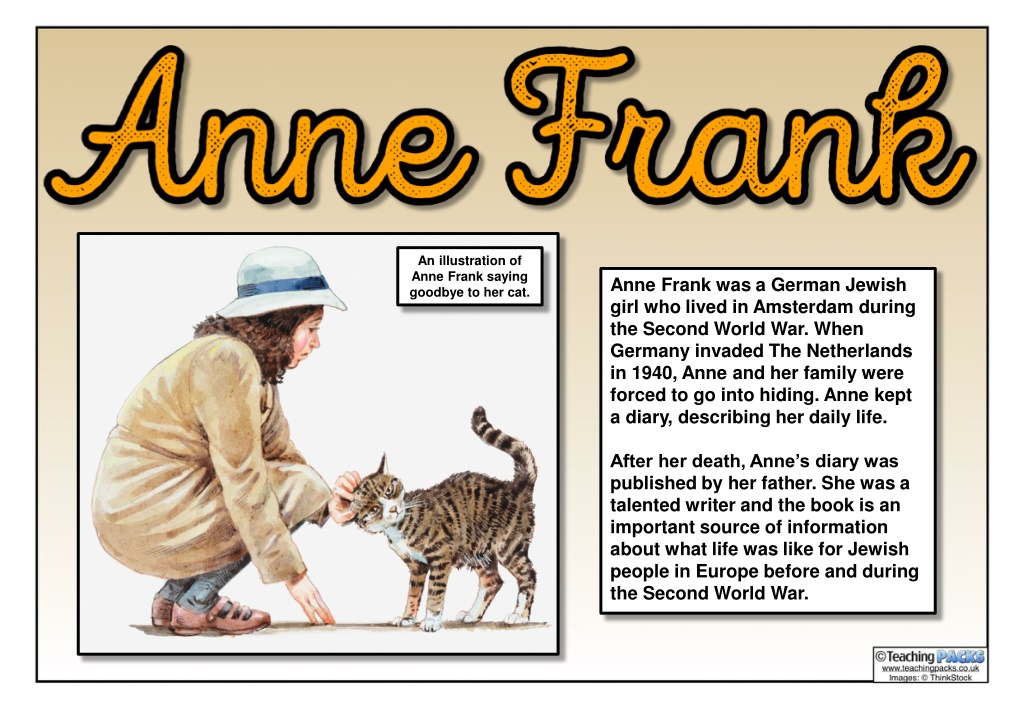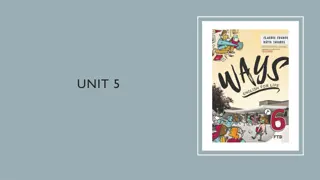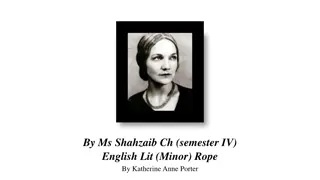Anne Frank: A Story of Courage and Resilience During World War II
Anne Frank, a German Jewish girl, lived in Amsterdam during World War II. Forced into hiding during the Nazi occupation, she kept a diary that later became a valuable account of Jewish life in Europe. Despite the challenges she faced, Anne's story of hope and perseverance continues to inspire generations.
Download Presentation

Please find below an Image/Link to download the presentation.
The content on the website is provided AS IS for your information and personal use only. It may not be sold, licensed, or shared on other websites without obtaining consent from the author. Download presentation by click this link. If you encounter any issues during the download, it is possible that the publisher has removed the file from their server.
E N D
Presentation Transcript
An illustration of Anne Frank saying goodbye to her cat. Anne Frank was a German Jewish girl who lived in Amsterdam during the Second World War. When Germany invaded The Netherlands in 1940, Anne and her family were forced to go into hiding. Anne kept a diary, describing her daily life. After her death, Anne s diary was published by her father. She was a talented writer and the book is an important source of information about what life was like for Jewish people in Europe before and during the Second World War.
Adolf Hitler, the leader of the Nazi party. The town square in Frankfurt, Germany. Anne was born in Frankfurt, Germany in 1929. She had an older sister, Margot. The family was Jewish, but they were not particularly religious. Anne s father Otto was a businessman who had been a soldier in the German army during World War I. Her mother Edith looked after the family. When Anne was young, the family had a happy settled life, but the political situation in Germany was uncertain. There were many changes of government. As the Nazi Party become more powerful, Jewish people living in Germany began to fear what life would be like if they were able to take charge. The leader of the Nazi party, Adolf Hitler, wanted to get rid of Jews from Germany.
In January 1933, Adolf Hitler became the Chancellor of Germany. This meant he was the most powerful person in the country. The Frank family prepare to leave Germany. Otto and Edith realised they were not safe in Germany, and moved the family to Amsterdam, in The Netherlands. About 300,000 Jews left Germany between 1933 and 1939. In Amsterdam, Anne started school and enjoyed reading and writing. She learnt to speak Dutch. Otto set up the Dutch Opekta Company, a company that sold ingredients for jam. The family felt safe in The Netherlands for a few years. Meanwhile in Germany, Hitler began attacks on Jewish people. In September 1939, Germany invaded Poland and World War II broke out.
In May 1940, Germany invaded the Netherlands. By October 1940, anti Jewish laws began to come into force. These immediately affected the daily life of the Frank family. Jews were banned from owning businesses, so Otto had to transfer his business shares to a friend (Johannes Keiman) to stop his company being confiscated. Anne and Margot had to leave their schools and go to a Jewish-only school. Jews were banned from public places such as parks, restaurants and libraries and in 1942 were ordered to wear yellow stars on their clothing. The German Empire at its peak.
On the 12th of June 1942, Anne received a book for her 13th birthday. She decided to use it as a diary and began writing in it daily. She called it Kitty. Anne wrote about her feelings and the events in her life. Anne wrote that she wanted to be an actress. She was not able to go to the cinema because Jews were not allowed in. Her father organised a film screening for her at home and she and her friend Jacqueline even made tickets for the event. The Royal Shakespeare Theatre in Stratford-upon-Avon. An illustration of Anne Frank and her family walking through Amsterdam.
An illustration of the Frank family hiding from the Nazis. In July 1942, Anne s sister Margot received an order to go to a labour camp. At these camps, people were forced to work in terrible conditions. The family had been expecting something like this to happen. Otto had prepared a hiding place inside his company building. Even though it wasn t quite ready, they moved in. They made it look like they had fled to Switzerland. In fact, they were hiding in a Secret Annexe at the back of Otto s Company s warehouse, behind a bookcase.
An illustration of Miep Gies riding her bicycle, carrying lots of food, to help Anne Frank and the other families in hiding. The family could not leave the Secret Annexe, so they had to have help to get supplies such as food. Only five people knew they were hiding in the annexe; four of Otto s workers, and the husband of one of them. The family were soon joined by four other Jews. The eight of them lived in constant fear of discovery. They got news from their helpers and the radio, which they could listen to when the workers went home for lunch and in the evenings. Life in the Annexe was very cramped and there were often arguments. During the day there were workers in the warehouse downstairs so they had to be extremely quiet. Anne passed the time by writing in her diary and studying.
The electric fence at Auschwitz concentration camp. The family hid in the Secret Annexe for two years. They were discovered by the German police in August 1944 and arrested. For a long time it was believed that someone had told the police about them, but it now seems likely that the police were investigating something else and found them by chance. One of the helpers, Miep Gies, collected Anne s diary and papers, intending to give them back to her after the end of the war. The family were taken to Auschwitz concentration camp where Otto was separated from his wife and daughters. Edith, Anne and Margot all became ill. Edith stayed at Auschwitz and died of starvation, while Anne and Margot were moved to Bergen- Belsen concentration camp. The shoes of prisoners in Auschwitz camp.
Anne and her sister Margot both died of typhus in Bergen-Belsen sometime around March 1945. Anne was 15 years old. Otto survived Auschwitz and returned to Amsterdam after the War. He soon found out that his wife and daughters had died, as had the other people who had been in hiding with them. When it was clear that Anne was dead, Miep Gies gave Anne s diary to Otto. In her diary, Anne had written that she hoped her diary would be published after the war, and had even rewritten some parts ready for publication. Otto was unsure at first but eventually decided to publish the diary. The first edition was published in the Netherlands in 1947. An illustration of Anne Frank and her ill sister, Margot Frank, dying of typhus fever, in Bergen-Belsen concentration camp.
Photos of the Anne Frank Museum in Amsterdam. Since 1947, the diary has been translated into 67 languages. Over 30 million copies have been sold. The Secret Annexe is now a museum. The Anne Frank Foundation, which runs it, also works to educate young people about civil rights and unequal treatment. Anne s diary has been made into plays and films and she is famous all over the world.

















































